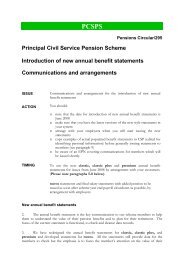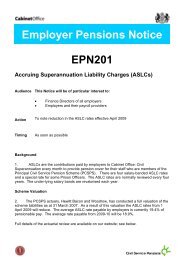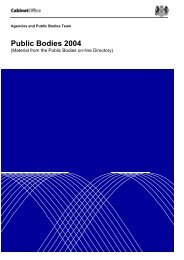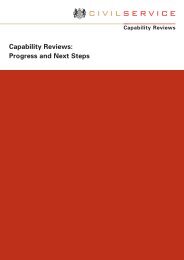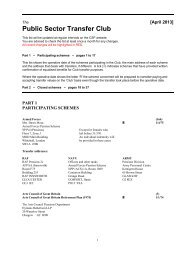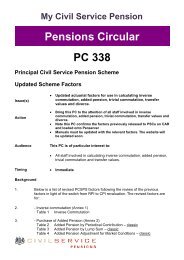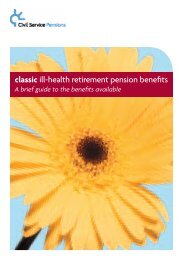Apart from gender, race and sexual orientation, age and disability,discrimination can occur in a range of other areas. Some examples to beaware of are: the devaluing of part-time jobs; one job group devaluing another(e.g. central/head office v field jobs, administrative v “specialist” roles, etc.);personal dislike of individuals; excessive emphasis on current status and jobtitles; and ‘double discrimination’ (i.e. multiples of these examples).In the Knowledge and Skills factor of JEGS you are asked at Questions 2 and3 to assess how long it will take for a person to acquire relevant skills andexperience in order to perform the role and to select one of the optionsavailable – ranging from 0-3 months up to more than 15 years. <strong>The</strong>se coverextremes and are not inherently biased. JEGS as a core methodology iscapable of assessing roles that can take a whole career to achieve and insome, albeit rare circumstances, you may encounter one. <strong>The</strong>y are likely tobe very specialist roles and as an example, may include senior lawyers,economists and scientists.<strong>The</strong> majority of roles for evaluation are unlikely to attract extremes.<strong>The</strong> root cause of discrimination in job evaluation can not only stem from jobevaluators, but also from role holders (e.g. over or under selling their role).Even the systems used can be challenged as discriminatory if they areinappropriate (e.g. if the factors used and/or the guidance that supports theuse of the factors is discriminatory).If job evaluation is to be effective and able to support a credible, acceptablegrading/pay banding structure, all forms of discrimination must be avoided.Essentially, therefore, best practice in job evaluation is about buildingprotection against possible discrimination throughout the job evaluationprocesses.2
ADOPTING OR REVIEWING JEGS<strong>The</strong> selection of the methodology to be used is key to ensuring that there isfair, consistent and systematic job evaluation. <strong>The</strong> most robust systems, andthe only ones recognised as valid by equal pay legislation, are analyticalmethodologies. Analytical systems break jobs down into identifiablecomponents and then measure them against a set of common criteria (orfactors). It is also important that the methodology reflects the core values ofthe business in which it is to be applied.JEGS is an analytical, points based system which has been developed torecognise core values of civil service roles below the Senior <strong>Civil</strong> <strong>Service</strong>. Ithas also been tested to ensure that it does not have any inherentdiscrimination. It is still recommended, however, that individual organisationsshould provide themselves with an assurance that it is suitable for theirbusiness. This assurance is required when first adopting JEGS and when youwant to review its suitability (e.g. when there has been significant changes inthe business such as machinery of government changes and when evaluatingpay and grading systems).<strong>The</strong> recommended stages for adopting or reviewing the suitability of JEGSare:-1. Set up a Steering/Working Group that represents the balance of theworkforce (e.g. from the main job families and locations, male andfemale, different business levels, trade union/staff organisationrepresentatives, etc.). It is important that there is senior managementinput to this group to ensure its authority.• Members of the group should have a clear understanding of theorganisation’s business strategy and objectives and of the jobs and keybusiness activities that are required to deliver them.• Members should also be aware of: the purpose of job evaluation; how itfits with other human resource systems (e.g. performancemanagement, competency frameworks, reward mechanisms, etc.);possible forms of bias in job evaluation; and the principles of the equalpay, race relations, Employment Equality (Age) Regulations 2006, anddisability acts.2. When adopting JEGS, the steering group should establish a jobevaluation/JEGS communication to all staff (e.g. the purpose of jobevaluation, how it will be applied in the organisation, the testingprocess, how staff will be up dated on progress, the format for issuingresults, etc.). This is essential if staff are to understand the purpose ofJEGS and accept it as a credible tool.3. Select a sample of key roles in the organisation on which JEGS can betested. <strong>The</strong> size of the sample will depend on the nature and diversityof the organisation. <strong>The</strong> roles selected should be representative of thediversity of the workforce (e.g. core business levels, main job families,different locations, etc.).4. Select the JEGS analysts who will evaluate the test roles (see “JEGS3




